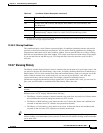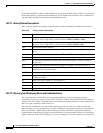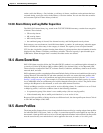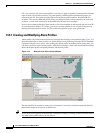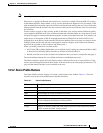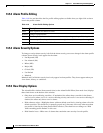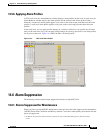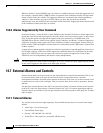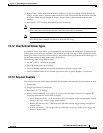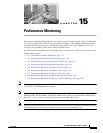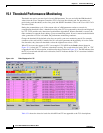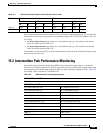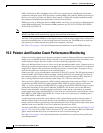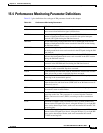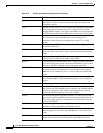
14-15
Cisco ONS 15454 Reference Manual, R8.5.x
78-18106-01
Chapter 14 Alarm Monitoring and Management
14.7.2 User Defined Alarm Types
• Raised When—Open means that the normal condition is to not have current flowing through the
contact, and the alarm is generated when current does flow; closed means that the normal condition
is to have current flowing through the contact, and the alarm is generated when current stops
flowing.
• Description—CTC alarm log description (up to 63 characters).
Note If you provision an external alarm to raise when a contact is open, and you have not attached the
alarm cable, the alarm will remain raised until the alarm cable is connected.
Note When you provision an external alarm, the alarm object is ENV-IN-nn. The variable nn refers to
the external alarm’s number, regardless of the name you assign.
14.7.2 User Defined Alarm Types
User Defined Alarm Types allows you to dynamically add and delete the alarm types. In addition to the
existing hard coded alarm type attributes, you can define up to 50 alarm types. These dynamically added
alarm types can be associated, or disassociated, to any external alarm input and the added alarm type can
use the same behavior as hard coded alarm type attributes.
The following limits and guidelines apply:
• An AIC or AIC-I card must be installed
• Up to 50 Alarm Types can be defined
• The User Defined name can be up to 20 alphanumeric characters (upper case).
• The User Defined name can not contain special characters or spaces (Hyphen (-) is allowed)
14.7.3 External Controls
You can provision each alarm output separately. Provisionable characteristics of alarm outputs include:
• Control type.
• Trigger type (alarm or virtual wire).
• Description for CTC display.
• Closure setting (manually or by trigger). If you provision the output closure to be triggered, the
following characteristics can be used as triggers:
–
Local NE alarm severity—A chosen alarm severity (for example, major) and any higher-severity
alarm (in this case, critical) causes output closure.
–
Remote NE alarm severity—Similar to local NE alarm severity trigger setting, but applies to
remote alarms.
–
Virtual wire entities—You can provision an alarm that is input to a virtual wire to trigger an
external control output.



